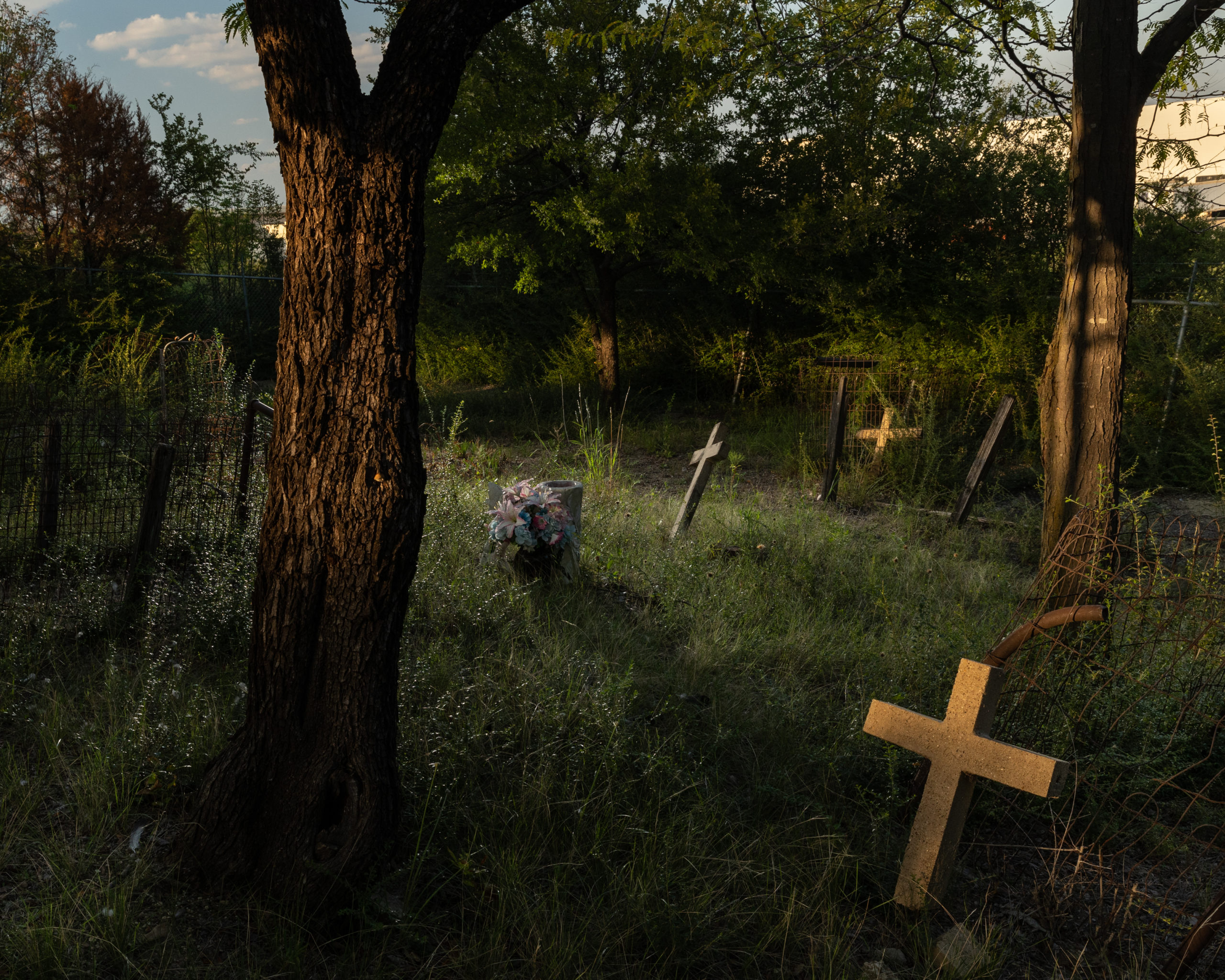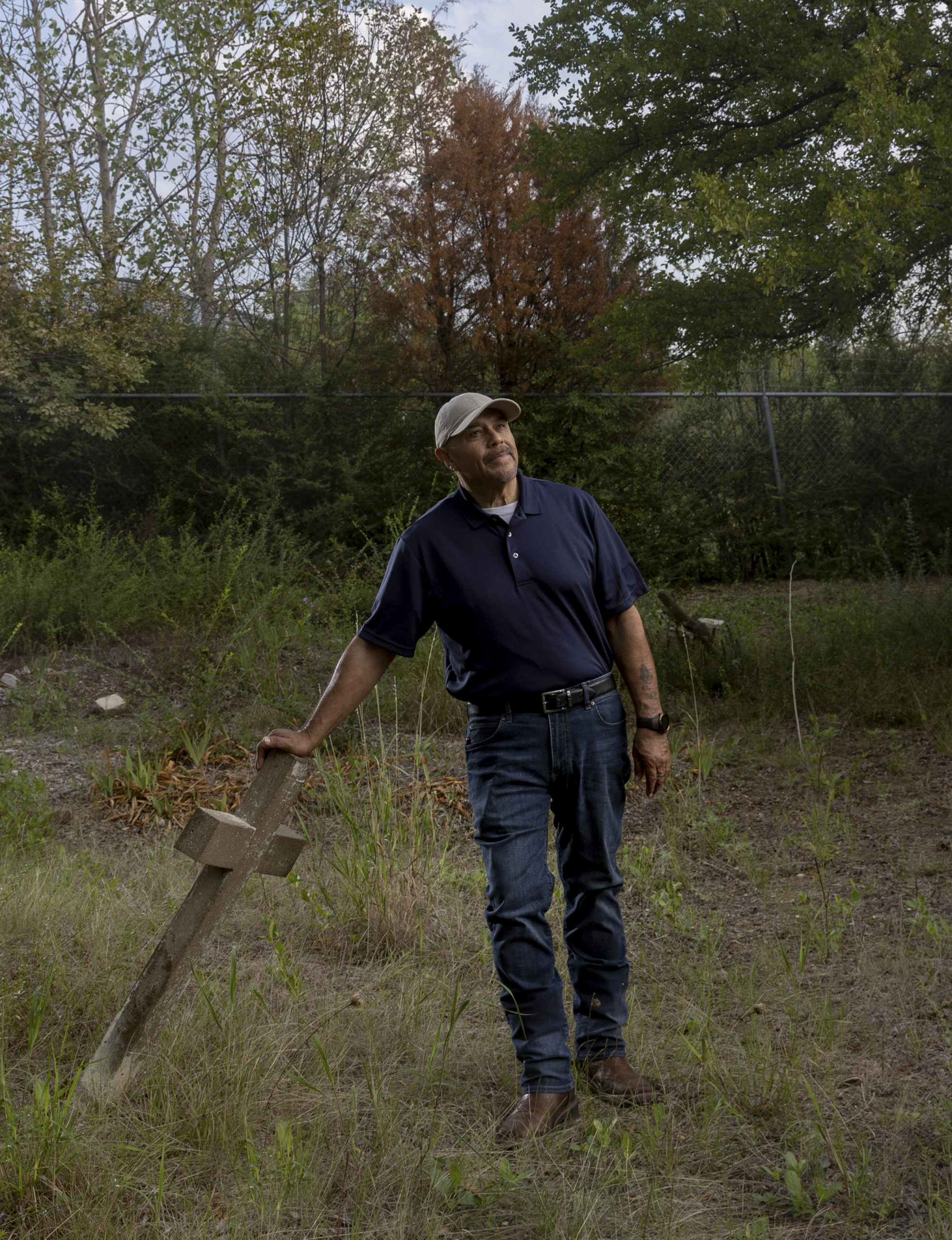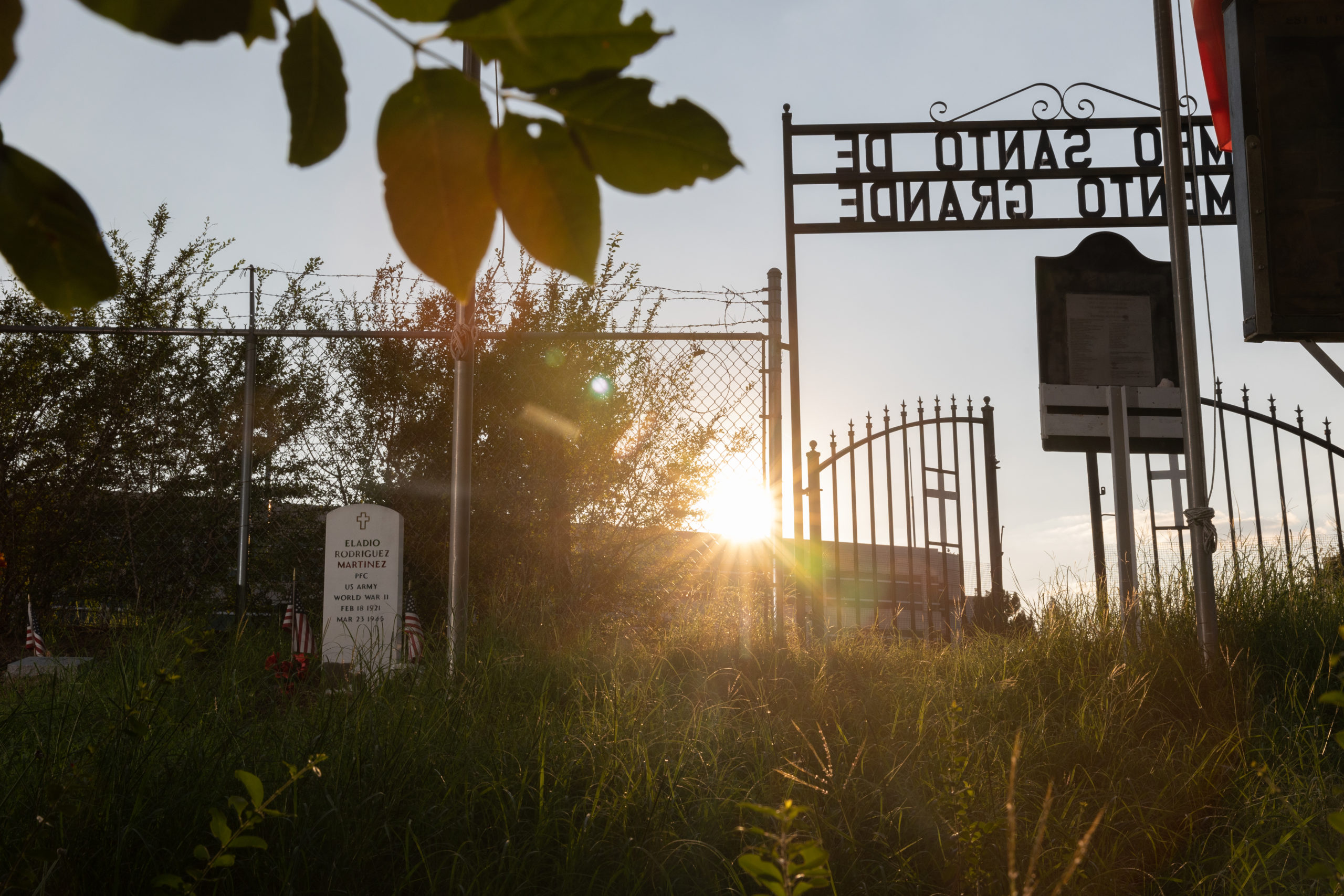
The Flowers of Campo Santo
In West Dallas, a volunteer group is creating a haven for monarch butterflies inside a historic immigrant cemetery.

On a muggy September morning, Henry Martinez Jr. brushed a thin layer of dust from his uncle’s tombstone, kneeling to reposition a bundle of red silk flowers knocked askew by the wind. Eladio Martinez, Henry’s uncle, was buried at the small cemetery in West Dallas in 1945 after being killed in World War II. His late aunt and grandmother lay in a row beside his uncle. “All the family is buried here and it brings back a lot of memories,” Henry Jr. says. “The old times and fun times.”
Henry Martinez Jr, 64, has spent countless hours here at Campo Santo de Cemento Grande. It’s the cemetery of the former Southwestern States Portland Cement company, founded in 1909, in what was once an independent city outside of Dallas known as Eagle Ford.
Here, Anglos and immigrant Mexican workers lived in segregated villages. Campo Santo is the final resting place of many of the Mexican laborers who helped build the city of Dallas in the early 1900s.
When he was a boy in the ’60s, Henry’s father, Henry Martinez Sr., would bring him and his brothers here to play. On the rare occasion when it snowed, the boys spent their mornings sliding down gentle, icy hills and trundling back to the top to do it all over again. In warmer weather, a stream that flowed to a small lake made for good fishing. The boys didn’t use fishing poles—instead, they would place a board across the creek and wait. “The fish would be flopping up over that board, and then we’d catch ‘em with our hands!” Henry Jr. said.

After sufficient time for play, Henry Sr. insisted that they pay respects to their family members and the 226 Mexican workers interred in Campo Santo. It’s both the oldest known Hispanic cemetery in Dallas County and a place that has long stood as a testament to the contributions of immigrant workers in North Texas.
“My dad let us have fun before we came [to the headstones], but this is sacred,” Henry Jr. said. “My dad, he loved this place. It was a place of rest for him. He would just come here and let it all out.”
But the city of Dallas has transformed into a sleek urban hub since then; the hum of traffic from Interstate 30 is now ever-present inside the cemetery, just south of the highway. At the same time, Campo Santo has been practicing a disappearing act. What used to be a two-acre lot in what’s now known as the Ledbetter/Eagle Ford neighborhood is a fraction of its former size. The lake was filled in at some point during the city’s frenzied development and the stream bed is dry. Vandals have fired shotguns and rifles at many of the headstones; privet, an invasive shrub that grows aggressively in Dallas County, has choked out native vegetation. Henry Jr. has tried to keep up with maintaining this space, but it’s too big a job for one man alone.
Now he’s getting help. With the assistance of members of the North Texas Master Naturalists, a service and education organization jointly coordinated and administered through Texas A&M University and the Texas Parks and Wildlife Department, the privet has been beaten back. This year, it was replaced by native plants with an eye toward attracting monarch butterflies.
This is more than just a beautification effort; there’s a deep symbolism at play here. Each spring, monarchs emerge from eggs and munch on milkweed before forming a chrysalis. Then, in the fall, the butterflies travel from North America to their wintering grounds in Mexico. Their life cycle is seen as a powerful symbol of migration and resurrection.
The project is the brainchild of Blanca Reyna, a Dallas native and master naturalist. Reyna said she immediately felt “enchanted” after being introduced to the cemetery. She set to work on a design that would pay homage to the site’s cultural significance. “How do I make this connection? How do I bring these communities together?” she asked herself.
She met with Henry Jr. and Victoria Ferrell-Ortiz, who also has family buried at the cemetery, and devised a plan to plant milkweed and other native plants to attract pollinators. Pairing the pollinator project with the cemetery seemed perfect, Reyna said. “It was like a ring on a finger.”

The project was approved by the North Texas chapter this year. They started the work on Martin Luther King Day, a holiday created to encourage volunteer service in underserved communities. Reyna and other volunteers tore out privet, installed 30 or so plants, and sowed an array of wildflower seeds.
What followed was a brutal summer drought and record heat. Not all of the plants survived, but thanks to diligent hand-watering and a deluge that dropped more than 13 inches of rain on some parts of the city in August, some plants were still standing. Among them was common milkweed, a perennial that’s a crucial food source for monarch caterpillars, and mountain mint, which has upright stems and clumps of small white flowers. Groupings of Mexican petunia have sprouted, their delicate purple flowers lighting up the shadows. It might take time for monarchs to find the new plants, but when they do, they’ll come back to Campo Santo year after year. Their migrations reinforce the idea that the cemetery has some sort of innate magnetism, one that compels living beings—plants and insects and humans—to return.
“It brings joy to my heart that the [master naturalists] did this,” Henry Jr. said. “It gives me something else to look forward to coming out here.”
He fought tears as he thought about his father, who died in 2019 at age 91, and all of the family history tied to Campo Santo de Cemento Grande. It’s a formative piece both of Henry Jr.’s identity, and of the community as a whole.
The Southwestern States Portland Cement company was tasked in large part with building the quickly growing city and required hundreds of workers. Anglos comprised part of the workforce, but Mexicans and Mexican Americans who fled from the state of Guanajuato during the Mexican Revolution also came to work at the site in what is now West Dallas. Henry Sr. was among them.
The company set about building two villages for its workers: one for Anglos and one for Hispanics, some of whom brought their families with them. The village for Hispanic workers came to be known as Cemento Grande. The company allotted two acres as a burial site for the Hispanics—in those days, segregation persisted even after death. Hundreds of workers and their family members were buried here until the last interment in 1945.
Just west of the cemetery is the Ledbetter/Eagle Ford neighborhood, groups of homes now set in the shadow of Interstate 30 and a fortress of big box stores. An old-school house that was part of Cemento Grande has been preserved and sits behind a Lowe’s. Historical markers posted at the school and elsewhere in the neighborhood are testaments to the area’s cultural significance.
The cemetery is a powerful place to visit for Victoria Ferrell-Ortiz, 29, whose 90-year-old wela—short for abuela— grew up in Cemento Grande. Her great-uncle died in the 1918 Spanish influenza epidemic as an infant and is buried at Campo Santo. Ferrell-Ortiz’s family, like Henry Jr.’s, were cementeros. But until 2016, she had little knowledge of this part of her family history. That’s when her wela saw fit to bring her to Campo Santo for the first time. She remembers watching her grandmother, who was 84 then, make the short but steep climb from an AT&T parking lot to the cemetery’s entrance, which sits on a hill. Slowly but surely they made their way to the top.
“Seeing my grandmother climb up this hill, it really drove home the importance to me,” Ferrell-Ortiz said. “She wanted to show me. She wanted to see her little brother.”
Ferrell-Ortiz, now a visual artist in Dallas, has made Campo Santo a focal point of her work, creating a documentary on its history and recreating its likeness through screen printing. Seeing the cemetery for the first time “was such an interesting moment in my life because it set me up for all the work I do now.”
“I’m very grateful to have that place. And I’m grateful to be able to connect other people to it who have history there. This is a history that a teacher can’t teach these kids because they don’t know.”
And there’s still more to do at Campo Santo. An information sign at the entrance of the cemetery, which contains photos of local families, is dirty and damaged by water.
Her acquaintance and ally Henry Martinez Jr. wants to get that fixed. He regrets that the cemetery has become smaller over the years due to urban development—in fact, he speculates that many graves within the cemetery’s original boundaries have been paved over to make a parking lot—but he tries not to dwell on it.
“It’s still here,” he said. “We’re going to keep working at it.”



